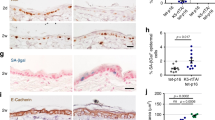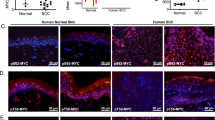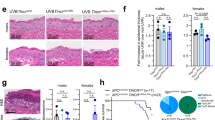Abstract
D-type cyclins are components of the cell-cycle engine that link cell signaling pathways and passage throughout G1 phase. We previously described the effects of overexpression cyclin D1, D2 or D3 in mouse epidermis and tumor development. We now asked whether cyclin D2 and/or cyclin D3 play a relevant role in ras-dependent tumorigenesis. Here, we described the effect of cyclin D3 and cyclin D2 overexpression in mouse skin tumor development. Notably, overexpression of cyclin D3 results in reduced tumor development and malignant progression to squamous cell carcinomas (SCC). Biochemical analysis of keratinocytes shows that overexpression of cyclin D3 results in strong reduction of cyclin D2 and its associated kinase activity. Furthermore, we found that reinstatement of cyclin D2 level in the cyclin D3/cyclin D2 bigenic mice results in a complete reversion of the inhibitory action of cyclin D3. Supporting these results, ablation of cyclin D2 results in reduced tumorigenesis and malignant progression. On the other hand, overexpression of cyclin D2 results in an increased number of papillomas and malignant progression. We conclude that cyclin D3 and cyclin D2 play opposite roles in mouse skin tumor development and that the suppressive activity of cyclin D3 is associated with cyclin D2 downregulation.
This is a preview of subscription content, access via your institution
Access options
Subscribe to this journal
Receive 50 print issues and online access
$259.00 per year
only $5.18 per issue
Buy this article
- Purchase on Springer Link
- Instant access to full article PDF
Prices may be subject to local taxes which are calculated during checkout





Similar content being viewed by others
References
Bartkova J, Lukas J, Strauss M, Bartek J . (1998). Cyclin D3: requirement for G1/S transition and high abundance in quiescent tissues suggest a dual role in proliferation and differentiation. Oncogene 17: 1027–1037.
Cheung TH, Yu MM, Lo KW, Yim SF, Chung TK, Wong YF . (2001). Alteration of cyclin D1 and CDK4 gene in carcinoma of uterine cervix. Cancer Lett 166: 199–206.
Ciemerych MA, Kenney AM, Sicinska E, Kalaszczynska I, Bronson RT, Rowitch DH et al. (2002). Development of mice expressing a single D-type cyclin. Genes Dev 16: 3277–3289.
Delmer A, Ajchenbaum-Cymbalista F, Tang R, Ramond S, Faussat A, Marie J et al. (1995). Overexpression of cyclin D2 in chronic B-cell malignancies. Blood 85: 2870–2876.
Dickson C, Fantl V, Gillett C, Brookes S, Bartek J, Smith R et al. (1995). Amplification of chromosome band 11q13 and a role for cyclin D1 in human breast cancer. Cancer Lett 90: 43–50.
Farkas T, Hansen K, Holm K, Lukas J, Bartek J . (2002). Distinct phosphorylation events regulate p130- and p107-mediated repression of E2F-4. J Biol Chem 277: 26741–26752.
Filipits M, Jaeger U, Pohl G, Stranzl T, Simonitsch I, Kaider A et al. (2002). Cyclin D3 is a predictive and prognostic factor in diffuse large B-cell lymphoma. Clin Cancer Res 8: 729–733.
Fujii M, Ishiguro R, Yamashita T, Tashiro M . (2001). Cyclin D1 amplification correlates with early recurrence of squamous cell carcinoma of the tongue. Cancer Lett 172: 187–192.
Hedberg Y, Roos G, Ljungberg B, Landberg G . (2002). Cyclin D3 protein content in human renal cell carcinoma in relation to cyclin D1 and clinico-pathological parameters. Acta Oncol 41: 175–181.
Houldsworth J, Reuter V, Bosl G, Chaganti R . (1997). Aberrant expression of cyclin D2 in an early event in human male germ cell tumorigenesis. Cell Growth Differ 8: 292–299.
Ito Y, Takeda T, Wakasa K, Tsujimoto M, Matsuura N . (2001). Expression and possible role of cyclin D3 in human pancreatic adenocarcinoma. Anticancer Res 21: 1043–1048.
Kiess M, Gill R, Hamel P . (1995). Expression of the positive regulator of cell cycle progression, cyclin D3, is reduced during differentiation of myoblasts into quiescent myotubes. Oncogene 10: 159–166.
Leng X, Noble M, Adams PD, Qin J, Harper JW . (2002). Reversal of growth suppression by p107 via direct phosphorylation by cyclin D1/cyclin-dependent kinase 4. Mol Cell Biol 22: 2242–2254.
Mariappan I, Parnaik VK . (2005). Sequestration of pRb by cyclin D3 causes intranuclear reorganization of lamin A/C during muscle cell differentiation. Mol Biol Cell 16: 1948–1960.
Matsushine H, Quelle DE, Shurtleff SA, Shibuya M, Sherr CJ, Kato JY . (1994). D-type cyclin-dependent kinases activity in mammalian cells. Mol Cell Biol 14: 2066–2076.
Meyerson M, Harlow E . (1994). Identification of G1 kinase activity for cdk6, a novel cyclin D partner. Mol Cell Biol 14: 2077–2086.
Miliani de Marval PL, Macias E, Conti CJ, Rodriguez-Puebla ML . (2004). Enhanced malignant tumorigenesis in Cdk4 transgenic mice. Oncogene 23: 1863–1873.
Pruneri G, Pignataro L, Valentini S, Fabris S, Maisonneuve P, Carboni N et al. (2005). Cyclin D3 immunoreactivity is an independent predictor of survival in laryngeal squamous cell carcinoma. Clin Cancer Res 11: 242–248.
Ramirez A, Bravo A, Jorcano J, Vidal M . (1994). Sequences 5’ of the bovine keratin 5 gene direct tissue- and cell-type-specific expression of a lacZ gene in the adult and during development. Differentiation 58: 53–64.
Robles A, Rodriguez-Puebla M, Glick A, Trempus C, Hansen L, Sicinski P et al. (1998). Reduced skin tumor development in cyclin D1 deficient mice highlights the oncogenic ras pathway in vivo. Genes Dev 12: 2469–2474.
Rodriguez-Puebla ML, LaCava M, Conti C . (1999). Cyclin D1 overexpression in mouse epidermis increases cyclin-dependent kinase activity and cell proliferation in vivo but does not affect skin tumor development. Cell growth Diff 10: 467–472.
Rodriguez-Puebla ML, LaCava M, Gimenez-Conti IB, Jonhson DG, Conti CJ . (1998a). Deregulated expression of cell-cycle proteins during premalignant progression in SENCAR mouse skin. Oncogene 17: 2251–2258.
Rodriguez-Puebla ML, LaCava M, Miliani de Marval PL, Jorcano JL, Richie E, Conti CJ . (2000). Cyclin D2 overexpression in transgenic mice induces thymic and epidermal hyperplasia whereas cyclin D3 expression results only in epidermal hyperplasia. Am J Pathol 157: 1039–1050.
Rodriguez-Puebla ML, Miliani de Marval PL, LaCava M, Moons DS, Kiyokawa H, Conti CJ . (2002). cdk4 deficiency inhibits skin tumor development but does not affect keratinocyte proliferation. Am J Pathol 161: 405–411.
Rodriguez-Puebla ML, Robles AI, Johnson DG, LaCava M, Conti CJ . (1998b). Synchronized proliferation induced by 12-O-tetradecanoylphorbol-13-acetate treatment of mouse skin: an in vivo model for cell cycle regulation. Cell Growth Differ 9: 31–39.
Sherr CJ . (1995). D-type cyclins. Trends Biochem Sci 20: 187–190.
Sherr CJ, Roberts JM . (1999). CDK inhibitors: positive and negative regulators of G1-phase progression. Genes Dev 10: 1491–1502.
Sicinska E, Aifantis I, Le Cam L, Swat W, Borowski C, Yu Q et al. (2003). Requirement for cyclin D3 in lymphocyte development and T cell leukemias. Cancer Cell 4: 451–461.
Sicinski P, Donaher J, geneg Y, Parker S, Garder H, Park M et al. (1996). Cyclin D2 is an FSH-responsive gene involved in gonadal cell proliferation and oncogenesis. Nature 384: 470–474.
Sicinski P, Donaher J, Parker S, Li T, Fazeli A, Gardener H et al. (1995). Cyclin D1 provides a link between development and oncogenesis in the retina and breast. Cell 82: 621–630.
Skapek SX, Rhee J, Spicer DB, Lassar AB . (1995). Inhibition of myogenic differentiation in proliferating myoblasts by cyclin D1-dependent kinase. Science 267: 1022–1024.
Wong SC, Chan JK, Lee KC, Hsiao WL . (2001). Differential expression of p16/p21/p27 and cyclin D1/D3, and their relationships to cell proliferation, apoptosis and tumour progression in invasive ductal carcinoma of the breast. J Pathol 194: 35–42.
Zhang S-Y, Liu S-C, Goodrow T, Morris R, Klein-Szanto AJP . (1997). Increased expression of G1 cyclins and cyclin-dependent kinases during tumor progression of chemically induced mouse skin neoplasms. Mol Carcinogen 18: 142–152.
Acknowledgements
We thank Dr Paula L Miliani de Marval and Dr Jonathan Horowitz for helpful reading and discussion of this paper, Dr Piotr Sicinski for providing the cyclin D2-null mice; Juan C Santiago for technical support, the Laboratory Animal Resources (LAR), and the CVM histology service personnel. This study was supported by NIH Grant CA116328.
Author information
Authors and Affiliations
Corresponding author
Additional information
Supplementary Information accompanies the paper on the Oncogene website (http://www.nature.com/onc).
Rights and permissions
About this article
Cite this article
Rojas, P., Cadenas, M., Lin, PC. et al. Cyclin D2 and cyclin D3 play opposite roles in mouse skin carcinogenesis. Oncogene 26, 1723–1730 (2007). https://doi.org/10.1038/sj.onc.1209970
Received:
Revised:
Accepted:
Published:
Issue Date:
DOI: https://doi.org/10.1038/sj.onc.1209970
Keywords
This article is cited by
-
Chloroquine regulates the proliferation and apoptosis of palate development on mice embryo by activating P53 through blocking autophagy in vitro
In Vitro Cellular & Developmental Biology - Animal (2022)
-
Cell cycle proteins as promising targets in cancer therapy
Nature Reviews Cancer (2017)
-
Alterations of gene expression and protein synthesis in co-cultured adipose tissue-derived stem cells and squamous cell-carcinoma cells: consequences for clinical applications
Stem Cell Research & Therapy (2014)



